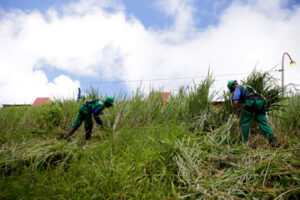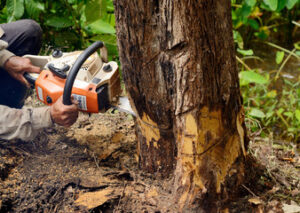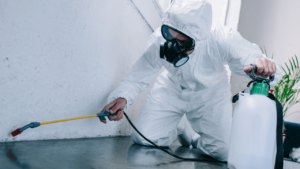Brush is woody vegetation that can include dead or nuisance-causing trees, bushes, and shrubs along with vines, stumps, and debris. This unwanted undergrowth is not only unsightly, but it also creates a fire hazard and attracts pests like snakes and rodents.

Removing brush is healthy for the landscape, and there are several ways to do it. These methods range from manual removal with tools like saws and clippers to machines like tractors or bulldozers. Contact Austin Brush Removal for professional help.
Brush removal is an important part of landscape maintenance and can help you maintain a healthy yard and garden. By regularly removing brush, you can prevent it from overtaking your property and reduce the risk of fire. In addition, a properly cleared lawn can enhance your home’s curb appeal and create a beautiful sanctuary for you and your family to enjoy.
There are several methods for clearing brush, including manual removal, mechanical clearance, chemical treatment, and controlled burns. The best method will depend on your needs and the size and density of the brush. You should also consider your budget, equipment and comfort level with using tools and chemicals.
During brush clearing, woody vegetation such as shrubs, dead or nuisance trees, and vines are removed to open up your landscape and make it more enjoyable for you and your family to enjoy. Overgrown vegetation is not only unsightly, but it can also block sunlight and water from reaching desirable plants. It can also harbor rodents and pests, such as ticks, ants, and mosquitoes. Additionally, dense brush can hinder the ability of seedlings to grow and can be a safety hazard for children and pets.
A variety of tools can be used to remove brush, including hand cutting with shears or loppers, a chainsaw, a weed eater, or a brush/clearing saw. The use of herbicides is another option for clearing brush, but it can be more expensive and requires special training or certification. In addition, it is important to follow proper precautions when using herbicides to avoid harming other plants and animals.
Commercial land clearing and brush removal is typically done with a specialized machine. This machine can cut, chip, and mulch brush to clear large areas of land for construction or landscaping projects. In addition, it can also clear out stumps and other debris. The machines can also be adapted to work around pipelines and other infrastructure.
Professionals who specialize in clearing and brush removal use a variety of equipment to efficiently and effectively clear land for residential and commercial purposes. The process is regulated, and professionals understand how to perform the clearance safely. They also know how to avoid damaging underground wires and pipelines, which can be a major problem for homeowners.
Chemical treatments
Chemical treatments of your hair can be a great way to achieve a desired look, but they can cause serious damage when not applied properly. The best way to ensure your hair stays healthy is to consult with a professional stylist who can advise you on the right type of treatment for your needs. However, there are also things you can do at home to help prevent hair damage from chemical treatments, such as taking a break from them or using a gentle shampoo and detangling gently.
Whether you are getting a coloring treatment, a straightening treatment or a perm, the chemicals used in these services are designed to alter the structure of your hair carefully. This can include breaking down disulfide bonds for a permanent wave or opening up the outer layer of your hair to allow dye molecules to penetrate for a color change. Having your hair brushed beforehand can disturb this delicate process by increasing the blood flow to the scalp. This can lead to a heightened response to the chemicals and can impact the results of your service.
Brushing before a chemical service can also increase your risk of scalp irritation and abrasions. The scalp is a sensitive area with many blood vessels and nerves. Brushing vigorously can create tiny abrasions on the surface of your scalp. Chemicals that are then applied to the scalp can penetrate these abrasions more easily, leading to chemical burns and irritation.
Controlled burns
If you live in a rural area, brush removal may involve a prescribed burn. These fires are conducted by trained professionals and can help reduce the risk of wildfire, as well as clear unwanted vegetation like weeds and invasive species. The goal is to make the landscape safer for wildlife and people, while also improving the appearance of the property.
Many forest eco-systems depend on fire to keep a healthy balance of vegetation and habitat conditions. Low-intensity prescribed burns help maintain open ground conditions by reducing brush and mid-story trees that block sunlight from the forest floor. This makes it easier for deer, dove and quail to find grasses, fruits and seeds. It also helps to promote oak habitats and their vital acorns for deer and other game animals.
Fire can also help restore sand and gravel prairies by burning away the invasive plants that compete for soil nutrients. It can even rejuvenate fens, a rare type of wetland that relies on regular fire to maintain its ecosystem.
The process involves using a trained fire crew and following a carefully written burn plan that considers local terrain, wildlife and weather patterns. Fire management staff often build a fire line or fuel break before staging a prescribed burn to help ensure it remains within the set boundaries. The burned areas are then allowed to cool down, and staff return to check that the area has been successfully managed.
If you are interested in conducting a prescribed burn, you can contact your state forestry commission or your local fire department to find out more about training programs and certification opportunities. You might also want to join a local prescribed burn association, which is a group of neighbors who help conduct burns and share resources.
Overgrown brush provides a natural breeding ground for pests, including ticks and rodents. Thick undergrowth can also inhibit the growth of trees and shrubs, while creating shade that hinders the development of native species. To avoid the hassle and expense of dealing with pests, it is important to regularly remove brush from your yard and outdoor stretches of land. There are a variety of different methods to do this, from manual removal with tools like saws and clippers, to using specialized equipment like bulldozers and tractors.
Hand removal
Brush removal can be difficult, especially when it’s persistent or deep-rooted. It requires a mix of tools and specialized equipment to get the job done right. Grazing livestock can help control brush growth, but may not be practical or suitable for all properties. Manual removal by hand allows you to address the roots and prevent regrowth, but is labor-intensive and time-consuming. Specialized equipment can be useful for large areas or thick, dense brush, but can also be expensive.
Removing brush and shrubs keeps your landscape healthy, helps plants grow properly, and improves the aesthetic of your property. Whether you have a small suburban lot with tame turf or a wild woodland, proper maintenance is essential to unlocking the potential of your landscape. The best time to remove brush is during the winter before new growth begins.








